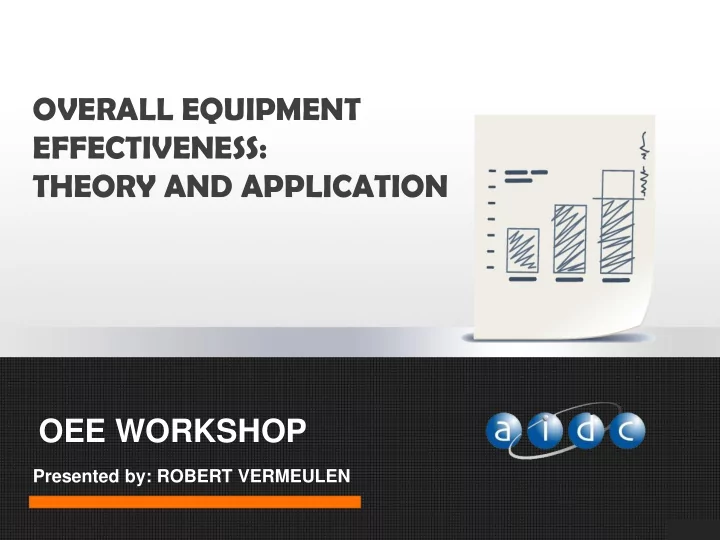

OVERALL EQUIPMENT EFFECTIVENESS: THEORY AND APPLICATION OEE WORKSHOP Presented by: ROBERT VERMEULEN
Evolution of OEE The TPM concept, launched by Nakajima in the 1980 ’s, provided a quantitative metric called Overall Equipment Effectiveness (OEE) for measuring productivity of individual equipment in a factory. It identifies ad measures losses of important aspects of manufacturing: • Availability • Quality • Performance OEE is the degree to which our equipment is doing what it is supposed to do
Evolution of OEE Analysis of OEE then led to the addition of more performance measures to fit different industries’ requirements: • TEEP= Total Equipment Effectiveness Performance • PEE = Production Equipment Effectiveness • OFE = Overall Factory Effectiveness • OTE = Overall Throughput Effectiveness • OAE = Overall Asset Effectiveness • OLP = Overall Labour Productivity The workforce strives to improve OEE by eliminating Six Big Losses
OEE Calculation Where: Ar = availability rate; Pr = Performance rate; Qr = Quality rate.
OEE Calculation Availability gives us what percentage of time the equipment is actually running, at its total capacity. • A = All considered working time (Total Work Hours) • Planned stoppage represents contractual breaks, etc. • B = Planned work time for equipment
OEE Calculation • B = Planned working time • Downtime represents total time for unscheduled stops (changeover time and adjustments) • C = Actual Working Time
OEE Calculation • Availability rate can be written as follows: • C = Actual Working Time • B = Planned Working Time
OEE Calculation • Reduced speed represents the loss from running at speeds less than optimum • D = Target output according to ideal cycle time (ideal cycle time per part x net operating time) • E = Actual output
OEE Calculation • If using the time ratio, the actual cycle time per part can be calculated from the Running Time(C) and Actual Output (E):
OEE Calculation • Performance rate can be written as follows: • E = Actual Output • D = Target Output
OEE Calculation • F = Actual Output (E) • Scrap, rejects is all not accepted units • G = Total good output
OEE Calculation • Using the above formula’s, the OEE rate can be expressed as:
OEE Model
OEE Example • Refer to handout exercise
TPM-OEE Productivity Model
OEE - Six Loss Calculation
OEE - Six Loss Calculation
OEE - Six Loss Calculation
OEE Example
OEE Example
OEE Example
OEE Rating
OEE Myths
OEE Myths
OEE Myths
OEE Myths
OEE Myths
OEE Myths
References • Jayaswal, Rajput and. "A Total Productive Maintenance Approach to Improve Overall Equipment Effectiveness." International Jounal of Modern Engineering Research , 2012: 4383-4386. • Mahdi, Almsafir and. "Diagnosing of Sustainable Competitive Advantage Using Six Sigma Methodology and Overall Equipment Effectiveness." International Jounal of Business and Management , 2012: 94-109. • MUNTEANU, et al. "POSSIBILITIES FOR INCREASING EFFICIENCY OF INDUSTRIAL EQUIPMENT." Series I: Engineering Sciences - Transilvania University of Brasov • Vol. 3 (52) , 2010: 199 - 205. • Optimumfx.com. "Overall Equipment Effectiveness (OEE) Explained." OptimumFX - Improvements Beyond Better , 2011. • Pintelon, et al. "Performance measurement using overall equipment effectiveness (OEE): Literature review and practical application discussion." International Journal of Production Research , 2006. • Samad, et al. "Analysis of Performance by OEE of the CNC Cutting Section of a Shipyard." ARPN Journal of Science and Technology , 2012: 1091-1096. • Wilmott, P. "The Myths and Realities of Implementing Overall Equipment Effectiveness." ME Plant & Maintenance , 2012: 14-20.
Recommend
More recommend